By Randy Scholfield
Take a look at this picture. Yes, there is hope for the Animas River.
You remember the Gold King mine spill from last August, which dumped 3 million gallons of toxic heavy metal sludge into the upper Animas and sent a yellow-orange plume sweeping downstream through Durango and on into New Mexico.
Amazingly, the spill didn’t seem to immediately impact the Gold Medal trout population through Durango. And a recent survey of the fish population confirmed that they’re doing well. Again, that picture, taken during the survey, speaks volumes.
But the fact remains that the Animas—and many other rivers and streams across the West—remain impaired by day-in, day-out toxic mine seepage. On the Animas watershed, the discharge amounts to a Gold King spill every few days. You can’t see it, but it’s there—and has been for decades.
That’s why the upper few miles of the Animas, below Silverton to about Cascade Creek, are largely barren of fish and aquatic life.
A couple weeks ago, I met my colleague Ty Churchwell for a tour of the new Superfund sites in San Juan County, including the Gladstone area, home of the Gold King Mine. It was eye-opening.
The abandoned mine complex surrounding the town of Silverton is extensive and daunting. Amid the spectacular fall colors and scenery, the mountains are pockmarked with leaking adits, tunnels and waste piles. For years, Churchwell told me, the Animas River Stakeholders Group has worked to identify and characterize each site – what’s the chemistry of the discharge, is the site public, private or abandoned?
The ARSG identified roughly 60 trouble sites, a mixture of point- and nonpoint-source (the former could be a leaking mine opening, or adit, the latter is more dispersed runoff, such as from a waste pile). And they set out to address some of the sites they could legally clean up (the non-point source sites).
Of those 60 sites, four are particularly bad and make up the lion’s share of pollutants entering the Animas watershed. These four mines alone contribute some 800-1,000 gallons per minute. That’s about 1 million gallons of toxic water flowing every 3 days out of these tunnels—the equivalent of a Gold King spill.
The EPA, in creating the Bonita Peak Mining District Superfund site, included 47 sites that together discharge about 5.4 million gallons a day into the Animas. That amounts to almost 2 Gold King spills every single day.
“The trout are the canary in the coal mine—they’re an indicator species,” says Churchwell. “We’re trying to bring back water quality in the Silverton area that will support a healthy ecosystem—that, in turn, will support a variety of uses, from recreation and agriculture to community water supply.”
Silverton is beginning to recognize the economic opportunity of a healthier river—cleaner water quality could lead to expanded opportunities for fly-fishing and tubing. And the Superfund remediation work itself could put many locals to work cleaning up mines.
Under the Superfund plan, the present temporary water treatment plant below the Gold King mine will eventually be replaced by a permanent water treatment plant that will tap the runoff of the four worst mines (all within a half-mile of each other) and pipe it to the treatment plant, where it will be brought up to standards and then discharged back into Cement Creek.
Good Samaritan legislation also remains a top priority for Trout Unlimited. Put simply, Good Sam creates a new discharge permit category that makes it easier for qualified Good Sam groups to help clean up abandoned mines. The permits allow for a lower standard for cleanups (30-50 percent, say, not 95 percent as under current Clean Water Act regulations) and there’s a sunset clause that doesn’t hold Good Sam groups responsible for cleanup costs in perpetuity– that’s been a financial dealbreaker for most groups.
The Bandora mine, which we reach on a rocky, bumpy four-wheel-drive road, is a great candidate for Good Sam, says Churchwell. We park and huff up to an old wooden mine structure, with orange runoff leaching down the hillside into South Mineral Creek, which eventually flows into the Animas.
Pointing to a broad valley below us, Churchwell says it’s a good place for a “bioreactor”—basically, a created marsh area that will naturally filter and clean the water over the long-term.
Taken together, these cleanup approaches could eventually bring the upper Animas below Silverton to a level of water quality that will support a healthy trout fishery. It probably won’t ever match the Gold Medal waters through Durango, but it could be a local source of pride and offer several miles of quality fishing.
Take another look at that trout picture. The Animas is worth fighting for—and TU is in it for the long haul.
Go to the We Are the Animas website to learn more about TU's efforts to clean up this great Western river.
Randy Scholfield is TU’s communications director for the Southwest region.






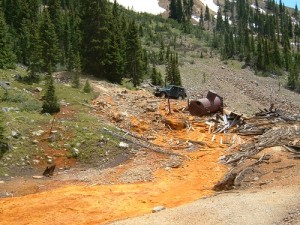 TU is currently working on three other NPS funded projects on the Illinois Gulch (Breckenridge), Evans Gulch (Leadville), and Leavenworth Creek (Georgetown) watersheds. The Environmental Protection Agency describes
TU is currently working on three other NPS funded projects on the Illinois Gulch (Breckenridge), Evans Gulch (Leadville), and Leavenworth Creek (Georgetown) watersheds. The Environmental Protection Agency describes 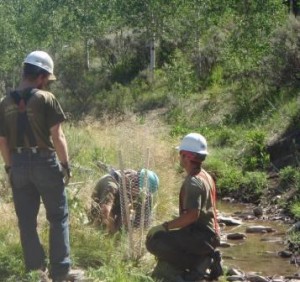
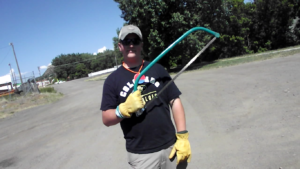 At the
At the 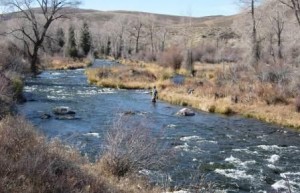
 Over the last decade population studies on the Animas have shown a decline. Although this year there wasn't a turn around, CPW Biologist Jim White told the Durango Herald, "It's been a really nice fish year. It’s definitely been more abundant than years past.”
Over the last decade population studies on the Animas have shown a decline. Although this year there wasn't a turn around, CPW Biologist Jim White told the Durango Herald, "It's been a really nice fish year. It’s definitely been more abundant than years past.” While the Animas is improving, the future of Cutthroat Trout in Hermosa Creek also have a bright future as stream improvements have been made to prepare for Colorado River Cutthroat reintroduction.
While the Animas is improving, the future of Cutthroat Trout in Hermosa Creek also have a bright future as stream improvements have been made to prepare for Colorado River Cutthroat reintroduction. Our chapter's ongoing conservation work on the South Platte River near Deckers strikes a chord with me. One of my earliest memories of being outdoors with my Dad is when he would take me there with his buddy and I would play in the shallows at the edge of the river. Later my good fishing buddy/college roommate and I spent many a pleasant weekend camping there and fishing those waters. Later on I had a great dog, a lab mix, and he would love to go along. We would do our best to keep him out of the water to avoid scaring fish, but he always managed to come home soaked, muddy, and contented. My buddy is busy with family now, and both my father and the dog have passed on. When the Hayman Fire roared through the area it broke my heart. Now the river is recovering with the help of our efforts, those of CUSP, and others. I am honoring the memories of those times I have spent on that river when I do my share to preserve its health and beauty.
Our chapter's ongoing conservation work on the South Platte River near Deckers strikes a chord with me. One of my earliest memories of being outdoors with my Dad is when he would take me there with his buddy and I would play in the shallows at the edge of the river. Later my good fishing buddy/college roommate and I spent many a pleasant weekend camping there and fishing those waters. Later on I had a great dog, a lab mix, and he would love to go along. We would do our best to keep him out of the water to avoid scaring fish, but he always managed to come home soaked, muddy, and contented. My buddy is busy with family now, and both my father and the dog have passed on. When the Hayman Fire roared through the area it broke my heart. Now the river is recovering with the help of our efforts, those of CUSP, and others. I am honoring the memories of those times I have spent on that river when I do my share to preserve its health and beauty.

 “It’s just transfer. It’s not like we’re selling them.”
“It’s just transfer. It’s not like we’re selling them.”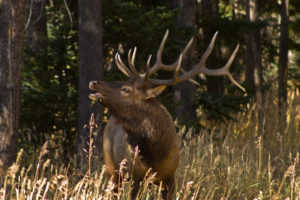 Public lands are for anglers, hunters, hikers, campers, backpackers, energy producers, mountain climbers, berry pickers, ranchers, horse packers, birders, timber operators, miners, snowmobilers, ATVer’s, mountain bikers.
Public lands are for anglers, hunters, hikers, campers, backpackers, energy producers, mountain climbers, berry pickers, ranchers, horse packers, birders, timber operators, miners, snowmobilers, ATVer’s, mountain bikers. Public lands are part of what define us as Americans. They are what remain of the great westward migration of the nation. They are the crucible upon which the character of the nation was formed. Our forebears left these lands to us, not so we could sell them to the highest bidder. They left them to us as an heirloom to pass on intact to the next generation. These lands are our birthright. They are a beacon of blinding and unwavering light on what it means to be free.
Public lands are part of what define us as Americans. They are what remain of the great westward migration of the nation. They are the crucible upon which the character of the nation was formed. Our forebears left these lands to us, not so we could sell them to the highest bidder. They left them to us as an heirloom to pass on intact to the next generation. These lands are our birthright. They are a beacon of blinding and unwavering light on what it means to be free.
